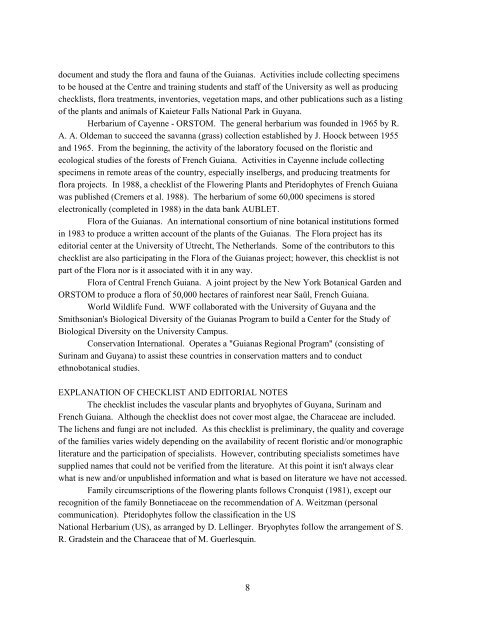Checklist of the Plants of the Guianas (1992) - Department of Botany ...
Checklist of the Plants of the Guianas (1992) - Department of Botany ...
Checklist of the Plants of the Guianas (1992) - Department of Botany ...
You also want an ePaper? Increase the reach of your titles
YUMPU automatically turns print PDFs into web optimized ePapers that Google loves.
document and study <strong>the</strong> flora and fauna <strong>of</strong> <strong>the</strong> <strong>Guianas</strong>. Activities include collecting specimens<br />
to be housed at <strong>the</strong> Centre and training students and staff <strong>of</strong> <strong>the</strong> University as well as producing<br />
checklists, flora treatments, inventories, vegetation maps, and o<strong>the</strong>r publications such as a listing<br />
<strong>of</strong> <strong>the</strong> plants and animals <strong>of</strong> Kaieteur Falls National Park in Guyana.<br />
Herbarium <strong>of</strong> Cayenne - ORSTOM. The general herbarium was founded in 1965 by R.<br />
A. A. Oldeman to succeed <strong>the</strong> savanna (grass) collection established by J. Hoock between 1955<br />
and 1965. From <strong>the</strong> beginning, <strong>the</strong> activity <strong>of</strong> <strong>the</strong> laboratory focused on <strong>the</strong> floristic and<br />
ecological studies <strong>of</strong> <strong>the</strong> forests <strong>of</strong> French Guiana. Activities in Cayenne include collecting<br />
specimens in remote areas <strong>of</strong> <strong>the</strong> country, especially inselbergs, and producing treatments for<br />
flora projects. In 1988, a checklist <strong>of</strong> <strong>the</strong> Flowering <strong>Plants</strong> and Pteridophytes <strong>of</strong> French Guiana<br />
was published (Cremers et al. 1988). The herbarium <strong>of</strong> some 60,000 specimens is stored<br />
electronically (completed in 1988) in <strong>the</strong> data bank AUBLET.<br />
Flora <strong>of</strong> <strong>the</strong> <strong>Guianas</strong>. An international consortium <strong>of</strong> nine botanical institutions formed<br />
in 1983 to produce a written account <strong>of</strong> <strong>the</strong> plants <strong>of</strong> <strong>the</strong> <strong>Guianas</strong>. The Flora project has its<br />
editorial center at <strong>the</strong> University <strong>of</strong> Utrecht, The Ne<strong>the</strong>rlands. Some <strong>of</strong> <strong>the</strong> contributors to this<br />
checklist are also participating in <strong>the</strong> Flora <strong>of</strong> <strong>the</strong> <strong>Guianas</strong> project; however, this checklist is not<br />
part <strong>of</strong> <strong>the</strong> Flora nor is it associated with it in any way.<br />
Flora <strong>of</strong> Central French Guiana. A joint project by <strong>the</strong> New York Botanical Garden and<br />
ORSTOM to produce a flora <strong>of</strong> 50,000 hectares <strong>of</strong> rainforest near Saül, French Guiana.<br />
World Wildlife Fund. WWF collaborated with <strong>the</strong> University <strong>of</strong> Guyana and <strong>the</strong><br />
Smithsonian's Biological Diversity <strong>of</strong> <strong>the</strong> <strong>Guianas</strong> Program to build a Center for <strong>the</strong> Study <strong>of</strong><br />
Biological Diversity on <strong>the</strong> University Campus.<br />
Conservation International. Operates a "<strong>Guianas</strong> Regional Program" (consisting <strong>of</strong><br />
Surinam and Guyana) to assist <strong>the</strong>se countries in conservation matters and to conduct<br />
ethnobotanical studies.<br />
EXPLANATION OF CHECKLIST AND EDITORIAL NOTES<br />
The checklist includes <strong>the</strong> vascular plants and bryophytes <strong>of</strong> Guyana, Surinam and<br />
French Guiana. Although <strong>the</strong> checklist does not cover most algae, <strong>the</strong> Characeae are included.<br />
The lichens and fungi are not included. As this checklist is preliminary, <strong>the</strong> quality and coverage<br />
<strong>of</strong> <strong>the</strong> families varies widely depending on <strong>the</strong> availability <strong>of</strong> recent floristic and/or monographic<br />
literature and <strong>the</strong> participation <strong>of</strong> specialists. However, contributing specialists sometimes have<br />
supplied names that could not be verified from <strong>the</strong> literature. At this point it isn't always clear<br />
what is new and/or unpublished information and what is based on literature we have not accessed.<br />
Family circumscriptions <strong>of</strong> <strong>the</strong> flowering plants follows Cronquist (1981), except our<br />
recognition <strong>of</strong> <strong>the</strong> family Bonnetiaceae on <strong>the</strong> recommendation <strong>of</strong> A. Weitzman (personal<br />
communication). Pteridophytes follow <strong>the</strong> classification in <strong>the</strong> US<br />
National Herbarium (US), as arranged by D. Lellinger. Bryophytes follow <strong>the</strong> arrangement <strong>of</strong> S.<br />
R. Gradstein and <strong>the</strong> Characeae that <strong>of</strong> M. Guerlesquin.<br />
8

















